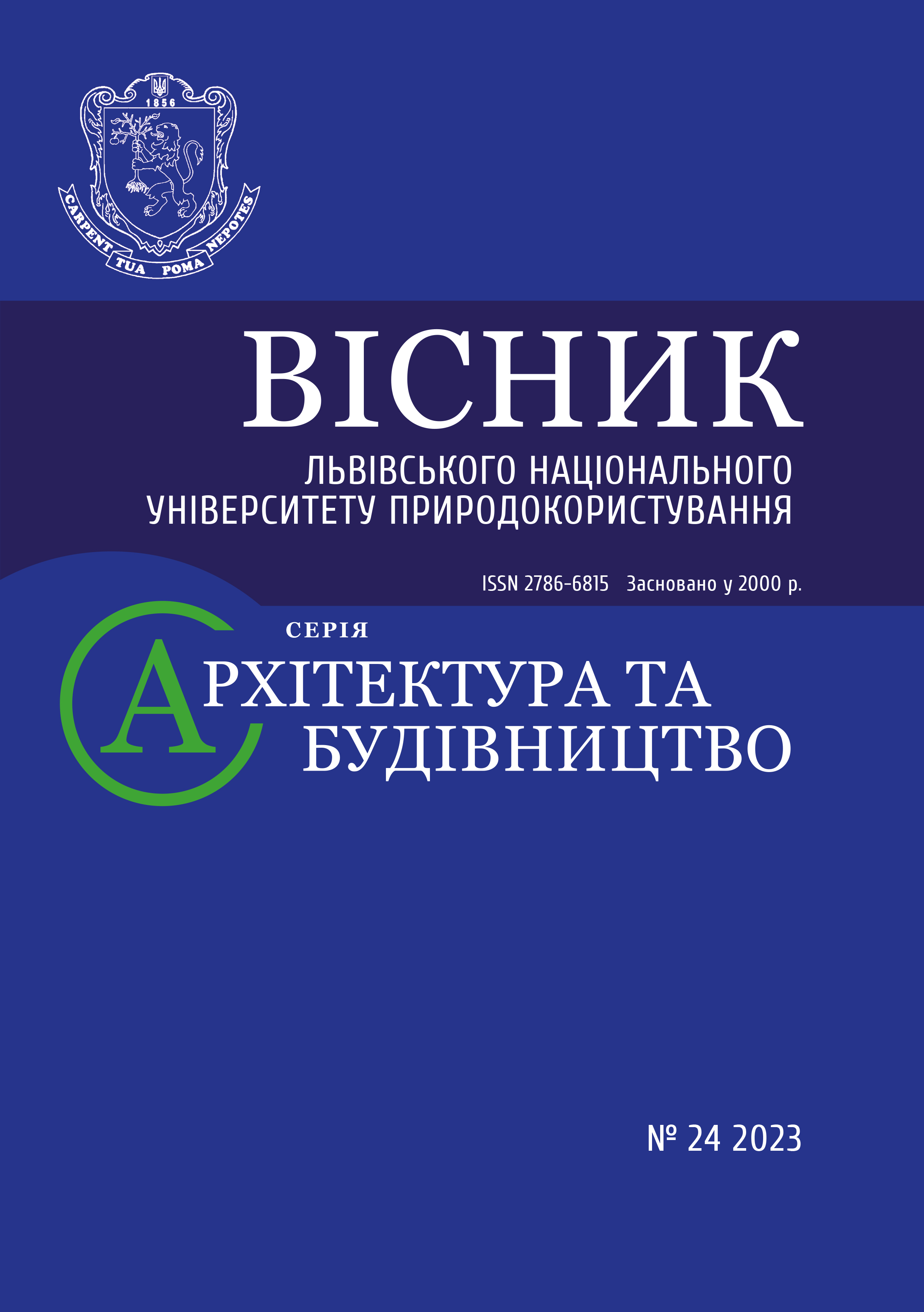МЕХАНІЧНІ ХАРАКТЕРИСТИКИ ПЕТ-ФІБРОБЕТОНУ ЗА КОРОТКОТРИВАЛОГО СТИСКУ
DOI:
https://doi.org/10.31734/architecture2023.24.052Ключові слова:
ПЕТ-фібра, ПЕТ-фібробетон, випробування, стиск, напруження, початковий модуль пружності, відносні деформації, діаграма деформуванняАнотація
Досліджено вплив відсотка ПЕТ-фібрового армування за об'ємом на міцність і деформативність дрібнозернистого бетону за короткотривалого стиску. На основі планованого повного двофакторного експерименту (ПФЕ 22) отримано рівняння регресії для розрахунку міцності на стиск ПЕТ-фібробетону.
Бетоном-матрицею слугував дрібнозернистий бетон класів С20/25 і С30/35, як таких, що використовують у конструкціях без попереднього напруження стрижнів. Коефіцієнти ПЕТ-фібрового армування за об’ємом прийнято rfv = 0,01 і rfv = 0,03 з урахуванням результатів, отриманих раніше. Як дисперсну арматуру використано фібру розмірами 40 × 3 × 0,2 мм, які обґрунтовані у наших попередніх дослідженнях. Міцнісність та деформативність ПЕТ-фібробетону за короткотривалого стиску вивчали за випробувань призм 100 × 100 × 400 мм.
Для отримання класу бетону С20/25 з розрахунку на 1 м3 прийнято такий склад: цемент ПрАТ «Івано-Франківськцемент» марки М400 активністю 42,3 МПа – 444,5 кг; пісок з модулем крупності 2,1 Ясинецького кар’єру – 1644,4 кг; вода – 239,2 л. Для отримання класу бетону С30/35 з розрахунку на 1 м3 прийнято такий склад: цемент ПрАТ «Івано-Франківськцемент» марки М500 активністю 53,1 МПа – 433,2 кг; пісок з модулем крупності 2,1 Ясинецького кар'єру – 1724,3 кг; вода – 215,6 л.
Показано, що підвищення відсотка фібрового армування збільшує міцність ПЕТ-фібробетону, початковий модуль пружності ПЕТ-фібробетону, зменшує відносні деформації за конкретної інтенсивності напружень. Запропонована математична модель для визначення міцності ПЕТ-фібробетону на основі планованого експерименту. Уточнена формула для розрахунку міцності ПЕТ-фібробетону, яку раніше використовували за розрахунку міцності на стиск сталефібробетону. Вказано на доцільність використання формули норм проєктування залізобетонних конструкцій для опису діаграми «напруження ‒ відносні деформації» ПЕТ-фібробетону за короткотривалої дії стиску.
Посилання
Adnan H. M., Dawood A. O. Strength behavior of reinforced concrete beam using re-cycle of PET wastes as synthetic fibers. Case Studies in Construction Materials. 2020. No 13.
Bilozir V. V. Formation and opening of cracks in normal sections of bending steel-fiber-concrete elements on a fiber from a sheet: dis. ... cand. tech. Sciences. Moscow, 1991. 164 p.
Bilozir Vit., Bilozir Vol. Justification of the parameters of fiber reinforcement from used polyethylene terephthalate. Bulletin of the Lviv National Agrarian University. Ser. Architecture and agricultural construction. 2016. No 17. P. 66–71.
DSTU B V.2.7-215:2009. Concretes. Rules of composition selection. To replace GOST 27006-86; effective 2010-09-01. Kyiv: Ministry of Regional Development of Ukraine, 2010. 1 p.
DSTU B V.2.7-217:2009. Concretes. Methods of determining prism strength, modulus of elasticity and Poisson's ratio. Kyiv: Ministry of Regional Development of Ukraine, 2010. 17 p. (National Standard of Ukraine).
DSTU-N B V.2.6-218:2016 Guide for the design and preparation of structures made of dispersed reinforced concrete. Kiev: DP «UkrNDNTs», 2017. 32 p. [Effective since 2017.04.01].
Dvorkin L. Y., Dvorkin O. L. Design of concrete compositions: monograph. Rivne: NUVHP, 2015. 353 p.
Dvorkin L. Y., Dvorkin O. L., Zhytkovskyi V. V. Solving construction and technological problems by methods of mathematical planning of the experiment: Study. manual. Rivne: NUVHP, 2011. 174 p.
Foti D. Use of recycled waste pet bottles fibers for the reinforcement of concrete. Construction and Building Materials. 2013. No 96. P. 396–404.
Kim J., Park C., Lee S. Effects of the geometry of recycled PET fibre reinforcement on shrinkage cracking of cement-based composites. Composites. 2008. No 39. P. 442–450.
Kinash R., Bilozir V. Deformational calculation method of bearing capability of fiber-concrete steel bending elements. Czasopismo Techniczne (Technical Transactions: Architecture), 2014. I. 8-A (15). No 111. P. 49–58.
Kinasz R., Bilozir V., Shmyh R., Bilozir V., Bidenko I. Examination of Concrete Elements Bending Strength Reinforced by Polyethylene Terephthalate (PET) Waste. IOP Conference Series: Materials Science and Engineering. 2019. Vol. 603.
Pacheco-Torgal F., Ding Y., Jalali S. Properties and durability of concrete containing polymeric wastes (tyre rubber and polyethylene terephthalate bottles): An overview. Construction and Building Materials. 2012. No 30. P. 714–724.
Recommendations for the design and manufacture of steel fiber concrete structures. Moscow: NIIZhB Gosstroy SSSR, 1987. 148 p.
Shmyh R. A., Bilozir V. V. Theoretical evaluation of the tensile strength of PET fiber concrete. Modern technologies and calculation methods in construction. 2022. Issue 18. P. 199–212.
Shmyh R., Bilozir V., Vysochenko A., Bilozir V. Сarrying capacity of bending concrete elements reinforced by fibro and stripes taken from used polyethyleneterephthalate bottles. International Scientific and Practica Conference World Science. 2018. No 2 (30). Vol. 1. Р. 88–93.
Sobczak-Piąstka J., Famulyak Y., Demchyna B. The application of non-traditional reinforcement in structural elements made of cellular concrete. AIP Conference Proceedings. 2023. Vol. 2949.
Won J. P., Jang C. I., Lee S. W. Long-term performance of recycled PET fibre-reinforced cement composites. Construction and Building Materials. 2009. No 24. P. 660–665.


